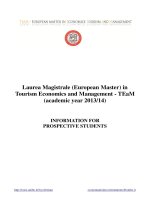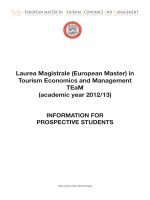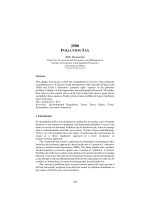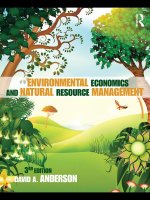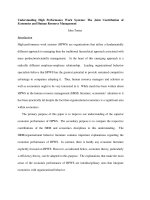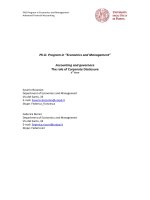Agricultural Management Economics and Sales Instructional Framework
Bạn đang xem bản rút gọn của tài liệu. Xem và tải ngay bản đầy đủ của tài liệu tại đây (376.04 KB, 37 trang )
Agricultural Management, Economics and Sales
Instructional Framework
An instructional framework provides educators with a list of benchmark statements aligned to Common Core and national content area
standards for a given course or program. The Missouri Agricultural Management, Economics and Sales Instructional Framework lists
a sequence of content, organized into distinct units of instruction.
The activities identified are designed to produce evidence that the competencies and related standards have been mastered. The
enhancements are suggested as opportunities to deepen learning around the stated competencies while meeting additional state and
national standards. The suggested activities and enhancements are outlined in more detail in the Agricultural Management, Economics
and Sales curriculum provided by MVATA.
Unit: Agribusiness in Today’s Agriculture Industry
Missouri
Missouri Learning
Agricultural
Standards
Education
Competencies
AT1 Agriculture Today
1. Describe the concept
of utility and identify
the five sectors of
agriculture and how
they fit together within
the industry.
2. Identify at least five
careers available in
agribusiness today.
CCSS.ELA-Literacy.W.11-12.1b
Agricultural Management, Economics and Sales (2014)
National
Standards
(AFNR)
Activity
(Evidence)
Enhancement(s)
CS.02.03.0.a
1. Students conduct indepth research on one
agribusiness career of
interest and create a trifold display that
synthesizes information
about the career’s
relationship with the
five sectors of
1. Students organize and
facilitate a panel
discussion with local
agribusiness professionals
about the topics of
agricultural sectors, utility
and free enterprise.
2. Students examine their
SAE program to identify
ABS.01.01.01.a
1
3. Explain the free
enterprise system
while examining
agribusiness at the
local, state, national,
and international level.
agriculture, the utility
provided by the career,
and the connection
between the career and
free enterprise systems.
the related sector(s) of
agriculture and type of
utility and create and
present electronic
presentation synthesizing
their conclusions.
3. Students organize and
facilitate an agribusiness
career fair for the entire
school.
AT2 Influences in Agribusiness
1. Outline government’s
role in and impact of
the agriculture
industry, its
involvement in
agribusiness, and its
effect on agricultural
prices.
CCSS.ELA-Literacy.CCRA.R.10
2. Explore government
agencies involved
with agriculture and
its effects on
agriculturalists and
issues in agriculture.
3. Identify current
issues in agriculture
and locate ways to
educate yourself and
others on these
issues.
CS.09.03.01.a.
CCSS.ELA-Literacy.RL.11-12.1
CS.09.03.01.c.
CCSS.ELA-Literacy.RI.11-12.3
CS.09.01.01.c.
CCSS.ELA-Literacy.W.11-12.1
CS.04.01.01.c.
CCSS.ELA-Literacy.W.11-12.6
CS.03.01.01.a.
CCSS.ELA-Literacy.W.11-12.9
CS.01.05.01.c.
CCSS.ELA-Literacy.SL.11-12.1
CS.01.05.01.b.
CCSS.ELA-Literacy.SL.11-12.3
CS.01.05.01.a.
Agricultural Management, Economics and Sales (2014)
1. Working in pairs,
students choose an issue
and use a variety of
online and print
resources to research
opposing viewpoints
and develop a portfolio.
Students present their
portfolio verbally to the
class and hold a
discussion on opposing
viewpoints.
1. Using a variety of online
and print sources, research
the impact of government
on agriculture by
examining the effects of
two specific government
programs such as CRP on
the economy and
agricultural productivity;
present research findings
in a written report.
2. Using government agency
websites, construct a
profile describing three
government agencies;
design and present an
electronic presentation to
the class to share findings.
3. Identify three online
sources of agricultural
information and evaluate
2
the reliability of each
source; present findings
verbally during a
classroom discussion.
4. Define advocate,
identify specific
ways to advocate for
agriculture, develop
agriculture related
Facebook status
updates, craft a letter
to the editor, and role
play a conversation
with an individual
opposing a specific
agricultural issue.
Unit: Economic Principles In Agribusiness
Missouri
Missouri Learning
Agricultural
Standards
Education
Competencies
EP1 Diminishing Returns
National
Standards
(AFNR)
Activity
(Evidence)
1. Define total product
(TP), marginal product
(MP), and average
product (AP) and
identify the
relationship between
them to illustrate the
principle of
diminishing physical
returns.
ABS.01.01.01.a
.
1. Students calculate
diminishing returns of
agricultural-related
situations in an effort to
establish the profit
maximizing solution.
CCSS.Math.Content.HSS-CP.A.1
Agricultural Management, Economics and Sales (2014)
ABS.04.01.02.a
.
ABS.05.01.01.c
.
Enhancement(s)
1.
Students examine their
Supervised Agricultural
Experience Program to
identify opportunities to
increase profits. Students
then chart the monetary
value of adding these
opportunities to their
program, calculate
3
2. Define total revenue
(TR), total cost (TC),
marginal revenue
product (MRP), and
marginal input cost
(MIC), and use them to
illustrate the principle
of diminishing
economic returns.
3. Define the point of
maximum profit and
maximum production
and the relationship
between the two.
ABS.04.01.02.a
.
diminishing returns, and
establish the point of
maximum profit.
EP2 Fixed and Variable Costs
1. Recall three
characteristics of fixed
costs and identity the
five types of fixed
costs.
2. Recall two
characteristics of
variable costs, identity
the three types of
variable costs, and
describe how a
variable cost becomes
fixed.
3. Define total cost;
classify expenses into
fixed costs or variable
costs; and examine the
total cost, fixed cost,
and variable cost
curves.
CCSS.Math.Content.HSN.Q.A.1
CCSS.Math.Content.HSACED.A.4
Agricultural Management, Economics and Sales (2014)
ABS.04.01.01.a
.
ABS.01.01.01.a
.
ABS.04.01.02.a
.
CS.01.04.03.a.
CS.01.04.03.b.
1. Students create a budget
for one month in college,
researching expenses
incurred living away
from home and attending
a four- or two-year
institution. After
identifying the fixed and
variable costs within the
budget, students
calculate and devise a
plan to decrease their
variable costs by 5% and
10%.
1. Complete a chart(s) by
calculating total cost, fixed
cost, variable cost, average
total cost, average fixed
cost, average variable cost,
and marginal cost given
limited information.
2. Figure per-units costs in
order to make educated
business decisions.
3. Review the previous
year’s expense pages of
the Missouri Record Book
and calculate average
fixed cost, average
variable cost, and average
total cost.
4
4. Identify the reason for
using per-unit costs
and represent the
equations for average
fixed cost, average
variable cost, and
average total cost.
5. Identify the difference
between short and long
run inputs and
resources.
EP3 Substitution
1. Define substitution and
describe the two
methods of
substitution.
2. Determine maximum
profit.
3. Determine and
calculate the best rate
of substitution.
CCSS.Math.Content.HSSMD.B.5b
ABS.04.01.03.a
.
CCSS.Math.Content.HSACED.A.4
ABS.01.01.01.a
.
CCSS.ELA-Literacy.SL.11-12.1
CS.02.04.01.c.
CCSS.ELA-Literacy.SL.11-12.4
CS.01.04.03.b.
Agricultural Management, Economics and Sales (2014)
1. Students will identify the
costs associated with
running the agriculture
department or school,
prepare an organized list
of these for closer
examination, come up
substitutes in order to cut
costs, and present these
substitutions and their
cost difference to the
class.
1. Figure the best rate of
substitution for given
agriculture-related
scenarios.
2. Review last year’s FFA
chapter budget, identifying
instances where
substitutions could be
made to decrease costs.
Present findings in the
form of a PowerPoint
presentation to FFA
officers and FFA
members.
3. With a local or area
business owner, students
examine their Supervised
Agricultural Experience
Programs to identify
where substitutions can be
made to decrease costs.
5
EP4 Opportunity Costs
1. Recall the definition of
opportunity cost and
net opportunity cost.
2. Identify two ways
business decisions are
affected by opportunity
costs.
3. Describe the effect of a
manager or business
owner not considering
opportunity costs.
4. Identify and calculate
one measure used to
represent opportunity
costs.
CCSS.Math.Content.HSN-Q.A.1
ABS.01.01.01.a
CCSS.Math.Content.HSS-IC.B.6
ABS.04.01.03.a
ABS.01.02.01.c
CS.01.04.03.a
CS.01.04.03.b
1. Student will identify
personal, school- and/or
work-related, and
Supervised Agricultural
Experience Programrelated decisions,
calculate the
opportunity costs of the
decisions, and justify
their reasoning based
upon the net return or
rate of return on
investment.
1. Review recent record
book entries, choose a
decision they made, and
evaluate the opportunity
costs of that decision.
EP5 Supply and Demand
1. Contrast demand and
quantity demanded,
define and illustrate
the Law of Demand,
identify three factors
that may shift the
demand curve, and
contrast luxury and
necessity items.
2. Contrast supply and
quantity supplied,
define and illustrate
the Law of Supply, and
identify three factors
that may shift the
supply curve.
CCSS.Math.Content.HSAREI.D.10
ABS.04.01.03.a.
CS.01.04.03.b.
CCSS.Math.Content.HSF-IF.C.7
CCSS.Math.Content.HSS-ID.A.1
CCSS.ELA-Literacy.W.11-12.7
Agricultural Management, Economics and Sales (2014)
1. Students will formulate a
survey to gather
information in providing
their assigned supply and
demand principles.
Upon gathering
completed surveys,
students will create a
demand schedule, supply
schedule, or chart/table
to capture the data and
create conclusion
proving or disproving
these principles,
identifying type of
1. Students find an article
from the gas and food
rationing time. Students
ask themselves what
factors would affect price
and present their
conclusions in a paper or
electronic format.
6
3. Demonstrate how to
determine price and
what factors affect
price to change,
determine the point of
equilibrium, and
identify the reasons for
surplus and shortage.
4. Define elasticity,
describe three types of
elasticity, calculate the
price elasticity for
supply and demand,
and illustrate the
importance of
understanding
elasticities.
elasticities, and
identifying types of
products. These
conclusions will be
presented through a
PowerPoint presentation
displaying data, graphs,
and any other pertinent
information.
EP6 Time Value of Money
1. Define time value of
money.
2. Define and calculate
the future value of a
dollar.
3. Define and calculate
the future value of a
dollar per period.
4. Define and calculate
sinking fund factors.
5. Define and calculate
the present value of a
dollar per period.
6. Define and calculate
the present value of a
dollar per period.
7. Define and calculate
amortization.
CCSS.Math.Content.HSN-Q.A.1
ABS.01.01.01.a
CCSS.Math.Content.HSASSE.A.1
ABS.04.01.03.a
ABS.04.01.02.a
CCSS.Math.Content.HSASSE.B.4
CS.02.04.01.c
CCSS.ELA-Literacy.SL.11-12.3
CS.03.01.01.a
CCSS.ELA-Literacy.W.11-12.2
CS.09.01.01.a
Agricultural Management, Economics and Sales (2014)
1. After participating in
class discussion and
completing the lesson’s
time value of money
scenarios, students will
locate articles on the
web pertaining to time
value of money,
discounting,
compounding, interest,
inflation, or other time
value of money topics,
take notes over these
articles, and craft a
sample blog entry about
key information in the
articles. Once blogs are
posted, students will
1. Invite a speaker from an
investment firm to talk to
the class about investments
and the time value of
money. Have students
summarize the key points
made by the speaker.
2. Give students an imaginary
savings account and have
them calculate how much
interest it is making and if
it would be more profitable
to invest this money or
leave it in savings. While
also assessing the positive
and negatives of both
options and what
circumstances might
7
8. Correlate the
connection between
time value of money
and inflation
review two blog posts
and respond stating their
agreement, opposition,
personal experiences
and/or how they might
use this information.
change their decision on
what to do with the money.
Unit: Agribusiness Planning and Analysis
Missouri
Missouri Learning
Agricultural
Standards
Education
Competencies
AP1 Starting an Agribusiness
National
Standards
(AFNR)
1. Sketch an
entrepreneur, using
pictures to illustrate
characteristics of a
successful
entrepreneur,
advantages of being an
entrepreneur, and
disadvantages of being
an entrepreneur.
2. Analyze business
opportunities by
examining market
potential and
recognizing factors
affecting the success or
failure of small
businesses.
3. Identify and explain
four regulations that
may affect the start-up
of an agricultural
business.
ABS.01.02.01.a.
CCSS.ELA-Literacy.SL.11-12.4
CCSS.ELA-Literacy.SL.11-12.1
Agricultural Management, Economics and Sales (2014)
Activity
(Evidence)
1. Students will craft
thoughtful interview
ABS.01.02.01.b.
questions for local
business owners that
ABS.06.01.02.a.
prompt engaging
answers. Students will
take detailed notes
related to the business
owner’s responses and
share their findings with
the class in a wellorganized report
containing accurate facts
and quotations from the
business owners.
Enhancement(s)
1. Gather a group of
entrepreneurs to class to
discuss how they began
their businesses, the
mistakes they made and
the successes they had.
Have students prepare
questions for the panel
and write a summary of
their takeaways.
2. Have students find an
article on a successful
entrepreneur and present
to the class how the
business got started and
other key points from the
article.
8
AP2 Developing a Business Plan & Goals
1. Create two SMART
short-term goals, two
SMART intermediate
goals, and two
SMART long-term
goals; prioritize these
goals and identify
three things the student
will do to help them
achieve these six goals.
2. Demonstrate the steps
in using a personal
time management
system.
3. Create a business
resume.
5. Create a business plan.
CCSS.ELA-Literacy.W.11-12.6
CCSS.ELA-Literacy.SL.11-12.1
CCSS.ELA-Literacy.L.11-12.1
CCSS.ELA-Literacy.L.11-12.2
BS.02.01.01.c.
1. Students will create a
1. Gather students in groups.
business resume for their
Have each student write 5
ABS.02.01.01.b.
school using some form
SMART goals for their
of media/technology
future in FFA and have
ABS.02.01.01.a.
instead or, or in addition
them share with their
to, a hard copy paper
small group. Have
ABS.02.02.02.a.
resume. To obtain
students discuss these
information and research
goals and if they meet the
CS.01.01.07.a.
for the resume, students
guidelines of SMART
will interview the local
goals.
CS.01.01.07.b.
superintendent, principal 2. Create a business plan and
or school board
have the class review and
CS.01.01.07.c.
members. In addition,
make suggestions on how
students will reference
to make it more complete.
CS.03.01.02.a.
sources within the school
Students will then take the
and the school’s
business plan to a local
CS.03.01.02.b.
webpage. Business
business owner for
resumes will be
critique and make the
presented to the class and
suggested changes.
judged by the
Students will then present
superintendent and/or
these changes to the class.
principal.
AP3 Selecting a Business Structure
1. Complete a
comparison chart over
the four types of
business structures.
CCSS.ELA-Literacy.SL.11-12.5
ABS.01.01.01.b.
CCSS.ELA-Literacy.SL.11-12.4
CS.02.04.01.c.
Agricultural Management, Economics and Sales (2014)
1. Students will create an
agribusiness pertaining
to their personal interest
and/or Supervised
Agricultural Experience
Program. Students will
decide the type of
business structure the
business will follow and
explore specifics on that
structure (who will use
the services, who owns
1. Students conduct further
research on business
structures on the IRS
Business Structures
website and have them
prepare a short
PowerPoint presentation
about the taxes and forms
associated with that
structure.
2. Students find and
participate in a blog
9
AP4 Financial Planning
CSS.ELA-Literacy.CCRA.R.9
1. Identify three reasons
for financial planning
and develop a personal
financial plan.
2. Create a personal
savings and investment
plan, identifying
specific ways to save
and invest money.
CCSS.ELA-Literacy.W.11-12.1
CCSS.ELA-Literacy.W.11-12.2
CCSS.ELA-Literacy.SL.11-12.3
Agricultural Management, Economics and Sales (2014)
ABS.04.01.01.a.
CS.02.04.01.c.
the business, who votes
and how, who if
financially liable, who
determines policy, who
receives profit, and how
the business is taxed.
Students will present
their business structure
plans to the class,
explaining the chosen
business structure and
orally justifying why
other business structures
did not work for their
business.
pertaining to agricultural
business structures.
Students will report to the
group what questions or
comments they
contributed on the blog
and the responses they
received.
1. Students will locate three
articles pertaining to
saving, investing,
financial planning, or
budgeting, take notes
over the articles, and
write a blog post about
the key information
learned. The blog post
1. Have students track their
income and expenses in
an excel spreadsheet for
two weeks. Have students
share with the class
changes they could make
to save 10 and 20%.
Classmates give feedback
10
3. Identify four reasons
for maintaining a
regular budget,
determine breakeven
price, and modify a
budget using a given
scenario.
AP5 Obtaining Financing for an Agribusiness
CCSS.ELA-Literacy.W.11-12.2 ABS.04.01.01.b.
1. Define three aspects of
business financing,
identify and describe
three sources of
business financing, and
illustrate two key items
a business should
provide to secure a
loan.
CCSS.ELA-Literacy.SL.11-12.1
Agricultural Management, Economics and Sales (2014)
ABS.04.01.02.c.
will incorporate how
students feel about the
information, tips they
have used in the past,
and how they plan to use
the information in their
life. Once blogs are
posted, students will read
and respond to two other
students’ blog posts,
commenting on their
agreement, opposition,
personal past
experiences, and/or how
they will personally use
the information.
on these proposed
changes.
2. Study the local FFA
chapter budget and have
them figure the
percentage of total
money used on each
broad activity. Do the
students have thoughts
on the percentage used
on these activities? Is the
highest percentage of
money used on the
activities that benefit the
most students? Are they
the most beneficial
activities? Have the class
create a chart with a
column for their
proposed changes to the
budget allotment.
1. Students will interview a
financial advisor, local
banker, or loan officer
creating questions
pertaining to obtaining
financing, credit, FICO
score, business
financing, or sources of
credit and financing.
1. Invite a loan officer to
class and have students
prepare questions on
FICO score, credit cards,
loans and other factors in
obtaining financing. Have
each student write down
their “top 3 factors” that
they feel are most
11
While administering the
interview as a class,
students will ask leading
questions and follow-up
questions to gain
complete understanding
of the above topics. At
the conclusion of the
interview, students will
type their questions and
responses and create
hash tags summarizing
the key points they took
away from the interview.
2. Describe the 5 C’s of
Credit, identify how a
FICO score is
calculated, and
compare and contrast
the four kinds of
credit.
important when trying to
obtain financing for a
business and share with
the class their list and
explanation of why they
selected those things.
2. Have students carefully
examine a sample credit
card application. Assign
each student research a
different term or condition
and create a visual to
present to the class on the
positives and negatives of
this condition.
AP6 Credit and Loans
1. Define two types of
loans, calculate asset to
liability ratio, and
define leverage and
how it can be
beneficial to a
business.
2. Identify three types of
credit institutions and
describe the loans they
provide; describe three
types of credit
instruments used by
lending agencies.
CCSS.Math.Content.HSACED.A.4
ABS.04.01.02.c.
ABS.04.01.02.a.
CCSS.Math.Content.HSN-Q.A.1
ABS.05.01.04.a.
CCSS.ELA-Literacy.SL.11-12.5
Agricultural Management, Economics and Sales (2014)
1. Students will use a
variety of examples
throughout the lesson to
practice calculating
interest. Upon
completing these
practice problems,
students will create info
grams to teach the
following concepts:
Types of loans, liability
ratio, leverage, and its
benefit to a business;
credit institutions and
1. Have students research
the types of loans
available to young
farmers and
entrepreneurs. They will
use internet sources, local
lending agencies and
bankers. They will then
create a 3 slide
PowerPoint presentation
on their findings and
present it to the class for
discussion. Students will
then compare the different
12
3. Define interest,
calculate simple
interest, calculate
compound interest, and
calculate an amortized
loan payment.
types of loans; and
interest.
types of loans researched
and evaluate the positive
and negatives of each.
2. Have students create a
amortized loan chart for a
20 year, $50,000 load at
8% interest. From left to
right the columns will
read: Year, Principal,
Interest, P+I, and Loan
Balance. Analyze how the
figures change over time
in the principal and
interest categories. How
would it change if the
lender was able to double
their principal in the first
5 years?
1. Students will use a
variety of examples
throughout the lesson to
practice calculating
liquidity, solvency, and
profitability. Upon
completing these
practice problems,
students will locate one
article pertaining to a
business struggling,
trying something new in
hopes of increasing
profits, or dealing with
1. Review the past two
year’s records, testing for
liquidity, solvency and
profitability. Compare
with the current year done
in class during lesson
review. What were the
positive and negative
changes. Have each
student write down three
SMART goals that could
improve results in the
coming years.
AP7 Analyzing Agribusiness Finances
1. Define two types of
loans, calculate asset to
liability ratio, and
define leverage and
how it can be
beneficial to a
business.
2. Identify three types of
credit institutions and
describe the loans they
provide; describe three
types of credit
instruments used by
lending agencies.
CCSS.Math.Content.HSASSE.A.1
ABS.04.01.02.a.
ABS.05.01.01.a.
CCSS.Math.Content.HSACED.A.4
ABS.05.01.01.c.
CCSS.ELA-Literacy.W.11-12.9
ABS.05.01.04.a.
CCSS.ELA-Literacy.W.11-12.2
Agricultural Management, Economics and Sales (2014)
13
3. Define interest,
calculate simple
interest, calculate
compound interest, and
calculate an amortized
loan payment.
controversy over a
2. Have students study the
business decisions.
past 5 year’s FFA chapter
After reading and
budgets to figure
reviewing these articles,
profitability. If the profit
students will create a one
margin seems large, have
to two paragraph
students present three
summary and identify a
ideas on how to
minimum of ten steps
efficiently use the extra
the company should do
money.
in analyzing the financial
effects of the decision
discussed within the
article.
AP8 Customer Credit
1. Define customer credit
and identify one
advantage and one
disadvantage to
extending credit to
customers.
2. Construct a sample
credit policy.
CCSS.ELA-Literacy.SL.11-12.5
CCSS.ELA-Literacy.L.11-12.1
CCSS.ELA-Literacy.L.11-12.2
Agricultural Management, Economics and Sales (2014)
ABS.06.05.01.b. 1. Students will create a
Customer Credit
ABS.06.05.02.b.
Portfolio of local
businesses’ credit
policies and credit
application processes.
Students will set up
interviews/meetings to
1. Have students find sample
letters that are sent to
overdue accounts. After
comparing and
contrasting these letters,
have each student write
one they would send their
customers if they owned
14
3. Describe how students,
as business owners,
would determine credit
standing for their
customers.
discuss their customer
their own business. When
credit policies and
each student presents their
request sample
letter to the class, have
documents they use to
them explain what makes
facilitate their customer
their letter great and why
credit policies. Students
they would more
will compile this
comfortable sending this
information in a threeto their customers then the
ring binder and provide a
samples they studied.
½ page reflection of the
2. Have students think
effectiveness of the
through what their system
customer credit policy.
would be if they owned a
business. What would be
the timeline for
delinquent accounts?
What steps would be
taken at each step in the
timeline- phone call,
letter, collection company,
etc?
AP9 Purchasing Property
1. Recall three
considerations to make
when considering a
parcel of land, describe
two ways to determine
property value, and
determine the legal
land description of a
parcel of land.
CCSS.ELA-Literacy.L.11-12.1
CCSS.ELA-Literacy.L.11-12.2
CCSS.ELA-Literacy.SL.11-12.1
Agricultural Management, Economics and Sales (2014)
ABS.02.01.02.b. 1. Students will set up an
1. Have each student
interview with a property
interview a local real
CS.03.01.01.a.
owner and craft
estate agent, or invite one
thoughtful interview
to class, where students
questions prompting
can ask questions on the
engaging answers on the
process of purchasing
topics owning property,
property. Following the
the sale of property,
interview, each student
property values, or other
should prepare a page
15
2. Explain the four steps
in purchasing real
estate, identify three
things to include in a
contract, and contrast
the three types of
deeds.
3. Describe four basic
elements of a real
estate transaction.
things discussed in this
lesson. Students will
take detailed notes of the
interview and present
their findings in a wellorganized report
containing accurate facts
and quotations taken
from the interview.
summary of what they
learned that can be used in
the future.
2. Assign each student a
sample property contract
to study (some will have a
contract for a house, land,
or a business property).
Each student will list the
key conditions of the
contract and present to
class. The class will then
discuss the differences in
these contracts and the
key things to look for.
AP10 Analyzing Capital Needs for An Agribusiness
1. Analyze a current
agribusiness in terms
of its land, labor,
capital, and
management.
2. Identify ways to
improve labor
efficiency, determine
labor needs for crop
enterprises, and
determine labor needs
for livestock
enterprises.
3. Identify opportunities
when outsourcing may
be profitable and
efficient for an
agribusiness.
CCSS.ELA-Literacy.L.11-12.1
ABS.05.01.03.a.
CCSS.ELA-Literacy.L.11-12.2
ABS.04.01.02.a.
CCSS.ELA-Literacy.SL.11-12.1
Agricultural Management, Economics and Sales (2014)
1. Students will use the
1. Have students find an
knowledge gained
article discussing the
throughout this lesson to
capital needs of
create a minimum fourAgribusiness and then
paragraph advice column
analyze how the capital
for an agribusiness
needs might change for
owner wishing to
different businesses: beef,
analyze the capital needs
dairy, and grain. Have
for his/her business. The
each student write a one
column will be written
page summary of their
as if a farmer had written
conclusions.
to the student wondering 2. Invite local agribusiness
about how to go about
people to class to discuss
this analysis.
their capital needs and
share their record keeping
and analysis tools. Each
student will write about
the 3 key things they
learned and present to the
class.
16
AP11 Machinery Analysis
1. Determine machinery
costs in relations to
fieldwork days and
implement selection.
2. Determine acceptable
custom rates for
Missouri.
CCSS.ELA-Literacy.L.11-12.1
ABS.05.01.03.a.
CCSS.ELA-Literacy.L.11-12.2
ABS.04.01.02.a.
CCSS.ELA-Literacy.SL.11-12.1
1. Students will read an
1. Have students find 3
article on Farm
articles online that discuss
Machinery Selection,
the differences between
take notes about what
owning and leasing
they read, and create a 3machinery. Each student
minute news
will present their findings
broadcast/interview
to the class along with
pertaining to the
their recommendations on
information learned from
what they would do if
the articles. Students
they owned an
will present their
agribusiness.
broadcast/interview to
the class.
AP12 Livestock Analysis
1. Justify three reasons
for raising livestock.
2. Explain considerations
to be made in selecting
livestock.
3. Analyze current
livestock publications
to determine the
profitability of
producing a particular
type of livestock.
CCSS.ELA-Literacy.L.11-12.1
ABS.05.01.03.a.
CCSS.ELA-Literacy.L.11-12.2
ABS.04.01.02.a.
CCSS.ELA-Literacy.SL.11-12.1
Agricultural Management, Economics and Sales (2014)
1. After participating in a
1. Have students prepare 5-8
variety of discussion
questions for a livestock
pieces throughout the
specialist. Have the
lesson, students will
specialist discuss raising
used their new
livestock, associated
knowledge of livestock
costs, and other things to
analysis to find 15
consider. Have students
sources of information a
turn in a brief report with
farmer could use to
the questions they asked,
assist in the analysis of
along with the answers
their livestock enterprise.
they received and any
Sources can be in the
other thoughts or
form of informative
takeaways they received
articles, newspaper
from the interview.
clippings, magazine
articles, or web tools.
After identifying these
sources, artifacts will be
collected and organized
using these sources.
17
AP13 Crop Analysis
1. Identify the important
characteristics in
planning a cropping
system.
2. Define and calculate
effective field capacity.
CCSS.ELA-Literacy.L.11-12.1
ABS.05.01.03.a.
CCSS.ELA-Literacy.L.11-12.2
ABS.04.01.02.a.
CCSS.ELA-Literacy.SL.11-12.1
CS.09.02.01.c.
CCSS.ELA-Literacy.W.11-12.1
CCSS.ELA-Literacy.W.11-12.2
Agricultural Management, Economics and Sales (2014)
1. Students will locate one
article about the cost and
returns of crop
enterprises, take notes
over the articles, and
write a blog post about
the key information
learned. The blog post
will incorporate how
students feel about the
information, tips they
have used in the past,
and how they plan to use
the information in their
life. Once blogs are
posted, students will
read and respond to two
other students’ blog
posts, commenting on
their agreement,
opposition, personal past
experiences, and/or how
they will personally use
the information.
1. Invite a crop specialist to
discuss planning a
cropping system,
associated costs,
appropriate rotations, etc.
Have students create 5-8
questions and turn in the
questions they got
answered and their key
takeaways from the
interview.
18
Unit: Agribusiness Management
Missouri
Missouri Learning
Agricultural
Standards
Education
Competencies
AM1 Business Decisions
National
Standards
(AFNR)
Activity
(Evidence)
Enhancement(s)
1. Personally identify
what drives the
decision-making
process, what
interferes with the
decision-making
process, the
consequences for
making a poor
decision, and the
rewards for making an
educated decision.
2. Define a problem and
illustrate each step in
the decision-making
process in order to
solve that problem.
3. Use the SWOT
Analysis to evaluate a
person and/or business
decision.
ABS.02.01.02.c.
1. Students will identify 10
factors to consider
before purchasing a new
car, research and record
relevant information for
four acceptable cars, and
use the SWOT Analysis
and the 7-step decisionmaking process to
choose the best option.
1. Identify a current decision
facing students’
Supervised Agricultural
Experience Programs.
Have them complete a
SWOT Analysis and/or
the steps in the decision
making process to identify
an appropriate solution.
Have students share their
results to the class and get
feedback.
CCSS.ELA-Literacy.SL.11-12.1
Agricultural Management, Economics and Sales (2014)
CS.02.04.01.c.
CS.03.02.01.a.
CS.03.02.01.b.
CS.03.02.01.c.
19
AM2 Agribusiness Records
1. Identify the use of
agribusiness records,
describe the three
types of accounting
systems, define three
special journals used in
agribusiness, and
illustrate the double
entry accounting
system.
2. Complete an income
statement by
identifying revenue,
cash expense, and
noncash expense; and
calculating gross
revenue, net income
from operations, and
net income.
3. Complete a balance
sheet by identifying
assets and liabilities;
calculating total assets,
total liabilities, and net
worth; and calculating
solvency and liquidity.
CCSS.ELA-Literacy.SL.11-12.1
CCSS.ELA-Literacy.W.11-12.2
CCSS.ELA-Literacy.CCRA.R.9
CCSS.ELA-Literacy.RL.11-12.1
Agricultural Management, Economics and Sales (2014)
ABS.05.01.01.a.
1. Students will find three
1. Examine last year’s actual
articles about
local FFA chapter budget.
ABS.05.01.01.b.
agribusiness records.
Have students prepare a
After reading the
cash flow and income
ABS.05.01.01.c.
articles, students will
statement. Have a class
record the main idea,
discussion on the cash
ABS.05.01.04.b.
specific examples, a
flow and income
point that surprised
statement and what
ABS.05.01.04.c.
them, and a question
conclusions they can draw
about the article.
from them.
Students and a partner
2. Invite a local tax
will then create a 3professional to class to
minute news
answer questions on how
broadcast/interview
agribusiness records are
pertaining to the
used to prepare taxes.
information learned from
Have students prepare
the articles. One person
questions and then turn in
will be the news
a one page summary on
broadcaster, and the
what they learned from
other will play any role
the interview.
pertinent to the
information presented.
20
4. Complete a cash flow
statement by
identifying income and
expenses and
calculating net total
and complete a cash
flow statement by
identifying operating,
financial, and investing
activities; and
calculating net totals.
AM3 Business Procedures
1. Define business
procedures and justify
their need.
2. Identify reports needed
in agribusiness.
3. Explain the use and
procedures for
guarantees and
warranties.
AM4 Contracts
1. Define contract,
identify three things to
consider when making
a contract, and identify
three legal aspects of
contracts.
CCSS.ELA-Literacy.SL.11-12.1
ABS.05.01.01.a
ABS.06.05.01.b.
CCSS.ELA-Literacy.W.11-12.3
ABS.02.01.02.a.
CCSS.ELA-Literacy.SL.11-12.1
ANS.07.02.02.b.
Agricultural Management, Economics and Sales (2014)
CS.02.04.01.c.
1. Using the knowledge
gained from the lesson,
student will select a
business type and title,
create a list of policies
for the business to
follow, and present these
policies in a PowerPoint
presentation.
1. Students will interview a
1. Upon completing
1. As a class or in small
discussions on contracts
and leases within this
lesson, students will use
the current SAE
Ownership Agreement
local agribusiness owner
to ask what business
procedures they use to
effectively run their
business and if these
procedures have changed
from the time they first
opened their business.
Each student will
summarize their interview
and their takeaways in a 2
page paper and give a
brief presentation to the
class.
groups create an FFA
member contract for local
FFA members. Speak with
chapter officers and the
advisor to determine what
21
CS.02.05.05.a.
2. Describe a lease and
the relationship
between the two
parties involved and
weigh the lessee’s
advantages and
disadvantages to
leasing.
3. Justify the need for an
automatic renewal
clause and explain how
to use arbitration.
4. Contrast a cash lease
with a production
share lease; identify
and define three types
of leases.
CS.02.05.05.b.
AM5 Employee Relations
CCSS.ELA-Literacy.SL.11-12.5
1. Identify the top three
characteristics
employers look for in
an employee,
demonstrate how
employees can be
successful, define
morale and its effects
on a business, and
define ethics and its
effects on a business.
2. Role-play how to
confront employees,
fix employee
problems, and respond
to employee issues.
CCSS.ELA-Literacy.SL.11-12.1
CCSS.ELA-Literacy.SL.11-12.3
Agricultural Management, Economics and Sales (2014)
Form 100 in the
Missouri Record Book,
knowledge from this
lesson, and other sample
contracts seen to create
an SAE Ownership
Contract.
ABS.02.04.01.b. 1. Following class
discussion about
ABS.02.04.03.a.
employee relations,
students will create four
ABS.02.04.03.c.
cartoons depicting
inappropriate employer
CS.03.02.02.c.
actions as discussion
within the lesson and the
CS.03.02.03.a.
corresponding
appropriate employer
action discussed in the
lesson. Students will
present their cartoons to
the class for feedback.
should be included in the
contract. Create and
present to FFA officers
and the advisor for
review. If appropriate,
present to the local FFA
chapter and adopt the
contract to use next year.
1. Invite several HR
professionals for a panel
discussion (perhaps the
school principal,
superintendent, human
resource director and local
business owners). Have
each student prepare
questions on their hiring
practices, interview
process, keys to what they
look for, impact of social
media, etc. Have students
prepare a top 10 list of
things they need to
improve or focus on
22
3. Craft two dialogues for
implementing change
in the workplace.
4. Identify five legality
issues of hiring
employees.
personally before
applying for a job.
AM6 Tax Management and Depreciation
1. Calculate taxable
income and analyze
the advantages and
methods of
maximizing after-tax
income.
2. Categorize income and
expenses.
3. Define depreciation,
calculate basis, and
calculate expensing.
4. Recognize the
importance and
benefits of reducing
and increasing taxable
income.
5. Calculate MACRS
depreciation.
CCSS.ELA-Literacy.L.11-12.1
CCSS.ELA-Literacy.L.11-12.2
CCSS.ELA-Literacy.W.11-12.2
CCSS.Math.Content.HSN-Q.A.1
CCSS.Math.Content.HSASSE.A.1
CCSS.Math.Content.HSASSE.B.4
ABS.04.01.02.a.
1. Students will practice
1. Have students practice
calculating tax figures
calculating depreciation
ABS.04.01.03.a.
and deprecation using
by using the Farm Doc
various examples
Finance Tools MACRS
ABS.04.01.03.b.
throughout the lesson.
Calculator. Use examples
Upon completing these
from class to plug into the
practice problems,
calculator.
students will find three
2. Invite a local tax advisor
articles about tax
to class to discuss tax
management, tax breaks,
management and
tax problem, or current
depreciation. Have
tax issues. After reading
students prepare 5-8
the articles, students will
questions. After the
summarize them using a
interview, each student
set of prompts. Finally,
will create 8 newspaper
students will create a 3headlines pertaining to the
minute news
main tips and takeaways
broadcast/interview
that they learned from the
pertaining to the
advisor.
information learned from
the articles. One person
will be the news
broadcaster and the other
will play any role
pertinent to the
information presented.
AM7 Tax Structure
1. Identify and describe
five federal taxes.
CCSS.ELA-Literacy.W.11-12.7
Agricultural Management, Economics and Sales (2014)
ABS.02.03.02.a. 1. Using knowledge gained
from lesson activities
1. Have students research
newspaper articles for
23
2. Identify and describe
three state taxes.
3. Identify and describe
two local taxes.
4. Identify taxes paid by
most people and
establish the difference
between a progressive
tax and a flat tax.
CCSS.ELA-Literacy.SL.11-12.1
ABS.04.01.03.b.
CCSS.ELA-Literacy.W.11-12.3
and discussion, students
will create a ten-question
survey to evaluate the
awareness of citizens
about taxes and tax
issues. Students will
tabulate their results in a
chart format and present
in a PowerPoint
presentation to the class.
regional tax issues and
then invite a local
politician or city official
to the class to discuss the
necessity of local taxes.
Have each student prepare
5-8 thought provoking
questions pertaining to
these issues. Following
the interview have
students summarize what
they learned and
formulate their own
opinions. Have them
summarize these thoughts
in a paragraph to turn in.
2. Have students brainstorm
what things they think are
important to know when
opening a business as it
relates to taxes. Invite a
tax preparer to class to
speak to students on
common misconceptions
and mistakes, specific
records to keep, etc.
Following the visit have
the class discuss as a
group and make a list of
their key takeaways.
AM8 Overview of Risk Management
1. Use a risk management
assessment tool in
examining a personal
decision.
CCSS.ELA-Literacy.W.11-12.7
CCSS.ELA-Literacy.SL.11-12.4
Agricultural Management, Economics and Sales (2014)
ABS.07.04.01.a.
1. Students will create an
8-question survey
ABS.07.04.01.b.
measuring the risk level
of various ages of
1. Brainstorm potential
activities for the local,
area, district and state
FFA associations. Next
24
2. Examine a business’s
current issue or
dilemma and use the
Risk Management
Model to develop a
solution to lower the
risk.
3. Indicate five ways
agribusinesses can
reduce risk.
ABS.07.04.01.c.
individuals. Survey
results will be presented
in an informational
poster and chart of the
individual’s risk level
and age correspondence.
have students identify the
risks involved with
incorporating these new
activities. Lastly, discuss
how students would use a
risk management model
and/or assessment tool to
elude or lesson the risks.
AM9 Cash Markets
1. Examine price
discovery methods
used in the United
States.
2. Define ways in which
commodity markets
are utilized in
agribusiness.
3. Explore the benefits to
the producer of using
cash markets.
CCSS.ELA-Literacy.SL.11-12.4
CCSS.ELA-Literacy.SL.11-12.5
ABS.07.04.01.a.
1. Using the knowledge
1. Have students select a
obtained through lesson
video about commodity
ABS.04.01.02.a.
activities and
marketing at
discussions, students will
www.marketschool.farms.
ABS.04.01.01.c.
create three info grams
com. After watching the
on the topics of price
video they will create a
ABS.04.01.03.a.
discovery, utilizing
short PowerPoint
commodity markets and
presentation depicting
CS.01.04.03.b.
the benefits of cash
what they learned.
markets.
AM10 Risk Management Tools-Commodity Markets
1. Explain how farmers
use a futures contract
and calculate a hedge.
2. Explain how farmers
use an option and
calculate an option.
CCSS.ELA-Literacy.W.11-12.1
ABS.07.04.01.a.
CCSS.ELA-Literacy.L.11-12.1
ABS.04.01.02.a.
CCSS.ELA-Literacy.L.11-12.2
ABS.04.01.01.c.
Agricultural Management, Economics and Sales (2014)
1. After completing the
1. Take a tour of the Kansas
lesson activities and
City Board of Trade. Visit
marketing calculations,
with a trader and get an
students will use the
idea of what a typical day
Marketing and Outlook –
in the life of someone at
Weekly Outlook section
the Board of Trade looks
25
